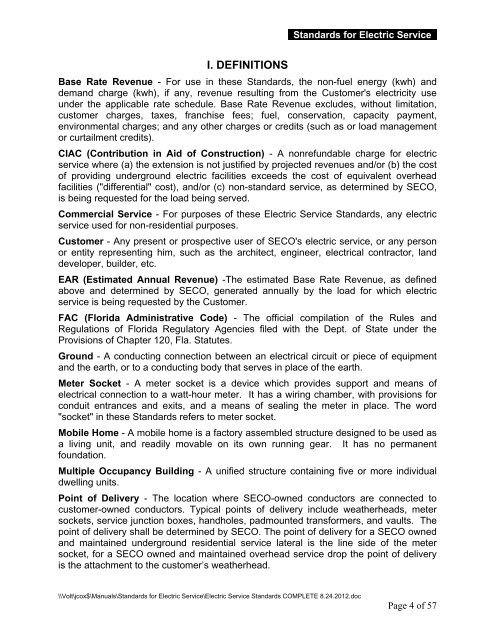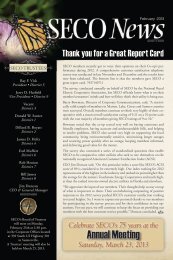Electric Service Standards - SECO Energy
Electric Service Standards - SECO Energy
Electric Service Standards - SECO Energy
You also want an ePaper? Increase the reach of your titles
YUMPU automatically turns print PDFs into web optimized ePapers that Google loves.
<strong>Standards</strong> for <strong>Electric</strong> <strong>Service</strong>x<br />
I. DEFINITIONS<br />
Base Rate Revenue - For use in these <strong>Standards</strong>, the non-fuel energy (kwh) and<br />
demand charge (kwh), if any, revenue resulting from the Customer's electricity use<br />
under the applicable rate schedule. Base Rate Revenue excludes, without limitation,<br />
customer charges, taxes, franchise fees; fuel, conservation, capacity payment,<br />
environmental charges; and any other charges or credits (such as or load management<br />
or curtailment credits).<br />
CIAC (Contribution in Aid of Construction) - A nonrefundable charge for electric<br />
service where (a) the extension is not justified by projected revenues and/or (b) the cost<br />
of providing underground electric facilities exceeds the cost of equivalent overhead<br />
facilities ("differential" cost), and/or (c) non-standard service, as determined by <strong>SECO</strong>,<br />
is being requested for the load being served.<br />
Commercial <strong>Service</strong> - For purposes of these <strong>Electric</strong> <strong>Service</strong> <strong>Standards</strong>, any electric<br />
service used for non-residential purposes.<br />
Customer - Any present or prospective user of <strong>SECO</strong>'s electric service, or any person<br />
or entity representing him, such as the architect, engineer, electrical contractor, land<br />
developer, builder, etc.<br />
EAR (Estimated Annual Revenue) -The estimated Base Rate Revenue, as defined<br />
above and determined by <strong>SECO</strong>, generated annually by the load for which electric<br />
service is being requested by the Customer.<br />
FAC (Florida Administrative Code) - The official compilation of the Rules and<br />
Regulations of Florida Regulatory Agencies filed with the Dept. of State under the<br />
Provisions of Chapter 120, Fla. Statutes.<br />
Ground - A conducting connection between an electrical circuit or piece of equipment<br />
and the earth, or to a conducting body that serves in place of the earth.<br />
Meter Socket - A meter socket is a device which provides support and means of<br />
electrical connection to a watt-hour meter. It has a wiring chamber, with provisions for<br />
conduit entrances and exits, and a means of sealing the meter in place. The word<br />
"socket" in these <strong>Standards</strong> refers to meter socket.<br />
Mobile Home - A mobile home is a factory assembled structure designed to be used as<br />
a living unit, and readily movable on its own running gear. It has no permanent<br />
foundation.<br />
Multiple Occupancy Building - A unified structure containing five or more individual<br />
dwelling units.<br />
Point of Delivery - The location where <strong>SECO</strong>-owned conductors are connected to<br />
customer-owned conductors. Typical points of delivery include weatherheads, meter<br />
sockets, service junction boxes, handholes, padmounted transformers, and vaults. The<br />
point of delivery shall be determined by <strong>SECO</strong>. The point of delivery for a <strong>SECO</strong> owned<br />
and maintained underground residential service lateral is the line side of the meter<br />
socket, for a <strong>SECO</strong> owned and maintained overhead service drop the point of delivery<br />
is the attachment to the customer’s weatherhead.<br />
\\Volt\jcox$\Manuals\<strong>Standards</strong> for <strong>Electric</strong> <strong>Service</strong>\<strong>Electric</strong> <strong>Service</strong> <strong>Standards</strong> COMPLETE 8.24.2012.doc<br />
Page 4 of 57








